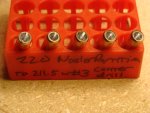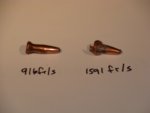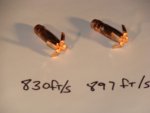Range Report Boat-tail backward ballistics
- Thread starter dbooksta
- Start date
You are using an out of date browser. It may not display this or other websites correctly.
You should upgrade or use an alternative browser.
You should upgrade or use an alternative browser.
I load em like this for my subsonic blackout. Out to 75-100 yd I have same point of impact as loading normal. Shot a deer with one this year and dropped it harder than anything else I have ever seen.
Is anyone aware of exterior ballistics data or coefficients on boat-tail bullets fired backwards (i.e., base first)?
A 150 grain .308 BT bullet fired backwards will have a BC in the neighborhood of 0.2, but it might be as low as 0.15.
You could approximate a backward boat tail bullet as an airfoil shape. This shape is known to have a lower coefficient of drag, but only at low speeds. Above Mach .3, where air is considered a compressible medium, is where this is no longer advantageous. Since Mach 1 is considered to be 1125 ft/s in dry air at 68F, you're looking at speeds under 337.5 ft/s. I imagine the behavior of the backward boat tail bullet would follow these guidelines pretty closely.
Last edited:
Took the words right outta my mouth.......You could approximate a backward boat tail bullet as an airfoil shape. This shape is known to have a lower coefficient of drag, but only at low speeds. Above Mach .3, where air is considered a compressible medium, is where this is no longer advantageous. Since Mach 1 is considered to be 1125 ft/s in dry air at 68F, you're looking at speeds under 337.5 ft/s. I imagine the behavior of the backward boat tail bullet would follow these guidelines pretty closely.
Except the transition between incompressible and somewhat compressible flow is considered to be ~.75 mach.
Except the transition between incompressible and somewhat compressible flow is considered to be ~.75 mach.
Everything I've used considers 5% change in density as compressible, which occurs around .33 Mach. .75 mach would be a much much greater relative change in density. Would you mind providing a source? If I'm considering this wrong, I'd like to know why.
Last edited:
Actually loading bullets backwards was practice for loading subsonic ammo as rough "teardrop" shape is appropriate for it. But as far as BC goes i would assume that for 1M and lower it would be quite ok while above disaster compared to correctly oriented BT bullet.
Everything I've used considers 5% change in density as compressible, which occurs around .33 Mach. .75 mach would be a much much greater relative change in density. Would you mind providing a source? If I'm considering this wrong, I'd like to know why.
Truth is I had several too many Gin and tonics last night and should of refrained from posting!
Thought I remembered that you could essentially assume "incompressible flow" up to ~.75 mach or so, but even a quick fact check shows that's wrong.
~.3 mach or so, as you indicated to begin with, is correct.
Been there, done that, got the alimony payments to prove it.Truth is I had several too many Gin and tonics last night and should of refrained ....
I've run 208s backwards in a 300blk, they don't expands much at sub speeds, thought it'd hit a little harder. They put things on their ass, I just can't get past the "this looks wrong" aspect.
Things have died either way.
Things have died either way.
Truth is I had several too many Gin and tonics last night and should of refrained from posting!
Thought I remembered that you could essentially assume "incompressible flow" up to ~.75 mach or so, but even a quick fact check shows that's wrong.
~.3 mach or so, as you indicated to begin with, is correct.
I've never in my life made a mistake because of gin. Ever. Probably because I can't stand gin. Whiskey fuels my mistakes. :-D No worries, I just wanted to make sure I didn't have my wires crossed. It's been a few years since I took fluids in college.
I've run 208s backwards in a 300blk, they don't expands much at sub speeds, thought it'd hit a little harder. They put things on their ass, I just can't get past the "this looks wrong" aspect.
Things have died either way.
No traditional rifle bullets currently available expand subsonic. (Looking forward to Norma importing their Plastic Points next year!)
From what I've tested nose first tends to upset faster. The reason I've been playing with them backwards is that they have an uncanny ability to "swim" straighter and further in water.
No traditional rifle bullets currently available expand subsonic. (Looking forward to Norma importing their Plastic Points next year!)
From what I've tested nose first tends to upset faster. The reason I've been playing with them backwards is that they have an uncanny ability to "swim" straighter and further in water.
We tested several in gelatin and published our results. See:
http://digitalcommons.unl.edu/cgi/viewcontent.cgi?article=1168&context=icwdm_wdmconfproc
I've never in my life made a mistake because of gin. Ever. Probably because I can't stand gin. Whiskey fuels my mistakes. :-D No worries, I just wanted to make sure I didn't have my wires crossed. It's been a few years since I took fluids in college.
I used to hate gin, but one night at the bar I got a hankering for a G&T, no idea why.
Thus began "the summer of Gin" for me.
I've eased back a LOT since then, but I sure do love me a G&T fixed 50/50 with New Amsterdam/Schweppes's and a 1/4 slice of lime.
Love some Whiskey too, but nothing beats Gin.
Subsonic Maximum Expansion Ammunition and Bullets
expensive but I think I'm going to have to buy a box.
Laupa makes a 200gr "subsonic" projective will prob give these a try as well
expensive but I think I'm going to have to buy a box.
Laupa makes a 200gr "subsonic" projective will prob give these a try as well
Yeah, there are a few pricey options like Lehigh Defense and Outlaw State. The Lapua 200gr subsonic bullets are (supposedly) optimized for external ballistics and accuracy. They absolutely will not expand.
We got good expansion and penetration with the 220 grain partition turned around and shot backwards after turning it into a hollow point with a #3 center drill. The final weight was 211.5 grains. This is probably the most cost effective approach for a subsonic .308 that has been shown to expand.
I can't post the video online, but I can attach the HS video of this bullet impacting ballistic gelatin to interested US parties who email a request to me at [email protected] . Reply will be a 10 MB email attachment, but request needs to include your real name, statement of citizenship, and current city of residence.
Attachments
Last edited:
We got good expansion and penetration with the 220 grain partition turned around and shot backwards after turning it into a hollow point with a #3 center drill. The final weight was 211.5 grains. This is probably the most cost effective approach for a subsonic .308 that has been shown to expand.
Do you have any photos post expansion? I noticed your paper said of back-drilled Partitions:
the expansion was minimal, and the soft lead did not maintain the maximum expanded diameter which probably reduced the retarding force, temporary cavity, and permanent cavity effects.
I tried drilling bullets for this purpose some time ago and testing them in a water tank: They would essentially shed fragments to the drill point and otherwise stay intact. I couldn't get any sort of mushroom effect.
Can someone please tell me why you would want to fire a bullet backwards? I've never head of this, just trying to gain some knowledge.
Do you have any photos post expansion?
Thanks for reminding me of the photos. Here are two of the back drilled partitions and their chronographed velocities. I've also attached a pic of two of the Lehigh Defense 200 ME bullets after impacting gelatin at the noted velocities. The X pattern of the 200 ME bullets is much different from the mushroom of the partitions, but I think the terminal results in both cases will be about the best you can hope for from the limited energy of a 200ish grain bullet at subsonic velocities. Remember that subsonic .308 bullets only deliver handgun levels of energy and are never going to provide comparable terminal effects of full power deer cartridges. You gotta make noise for that.
And speaking of noise, even if a subsonic bullet makes a very loud sound when hitting a deer or other live animal target in the chest. We published a paper a while back on reconstructing shooting events from the sound of the bullet hitting the target.
Attachments
Can someone please tell me why you would want to fire a bullet backwards? I've never head of this, just trying to gain some knowledge.
The biggest reason is enhanced terminal effects. If a bullet is not going to expand, the flat surface will create more damage than a pointy tip. We've also found that backwards bullets (150 FMJ) deflect less than all the frontwards loaded bullets we tested when striking brush. (We used 0.5" diameter wooden dowels to simulate brush.) One can also load 150 FMJ bullets backwards for a 30/30 with a tube mag to avoid bullet points lining up with primers. Backwards loaded bullets of many designs also have a better chance to penetrate barriers or armor than frontwards loaded bullets. We're a ballistics test lab (BTG Research), so we do a lot of stuff the average joe never considers.
And speaking of noise, even if a subsonic bullet makes a very loud sound when hitting a deer or other live animal target in the chest. We published a paper a while back on reconstructing shooting events from the sound of the bullet hitting the target.
Wow. Stop teasing! Where's a copy?
That's one of the reasons I stopped using a .22LR for small game and switched to a .20 airgun. There's something very viscerally satisfying about the solid THWACK! a round-nosed pellet makes when you get a good, solid hit....And speaking of noise, even if a subsonic bullet makes a very loud sound when hitting a deer or other live animal target in the chest. We published a paper a while back on reconstructing shooting events from the sound of the bullet hitting the target.
Besides the better terminal effects, long, skinny (high-ogive) bullets also are more stable when fired backwards. When they're supersonic, their stability actually is aided by the SS shockwave. But if they're fired subsonic, they don't get that assist.Can someone please tell me why you would want to fire a bullet backwards? I've never head of this, just trying to gain some knowledge.
The typical twist for a .308 is 1:12, but the standard twist for a .300 AAC/Blackout/Whisper is 1:8, a reflection of the fact that it's optimized for SSS loads. So to get bullets to stabilize from a standard-twist bbl at SSS velocities, one fix is to shoot your bullets backwards, fat end first, because they're easier to stabilize that way. The aerodynamics suck, but that's not as much of a factor when subsonic.
Wow. Stop teasing! Where's a copy?
The journal article is here: Using sound of target impact for acoustic reconstructions of shooting events but unless you have library access to that journal, you may not be able to see the full article, so we have linked it from our web site here: http://www.btgresearch.org/AcousticReconstruction02042012.pdf
Some background and other work testing subsonic handgun bullets in deer is here: http://arxiv.org/ftp/physics/papers/0702/0702107.pdf
That's one of the reasons I stopped using a .22LR for small game and switched to a .20 airgun. There's something very viscerally satisfying about the solid THWACK! a round-nosed pellet makes when you get a good, solid hit.
Besides the better terminal effects, long, skinny (high-ogive) bullets also are more stable when fired backwards. When they're supersonic, their stability actually is aided by the SS shockwave. But if they're fired subsonic, they don't get that assist.
The typical twist for a .308 is 1:12, but the standard twist for a .300 AAC/Blackout/Whisper is 1:8, a reflection of the fact that it's optimized for SSS loads. So to get bullets to stabilize from a standard-twist bbl at SSS velocities, one fix is to shoot your bullets backwards, fat end first, because they're easier to stabilize that way. The aerodynamics suck, but that's not as much of a factor when subsonic.
Thank you for the Input. So they are more stable ( not to key hole and goes where you want them, but range is suffered due to aerodynamic being bad?)
What are SSS loads?
Using tapatalk
SS = supersonic...What are SSS loads?...
SSS = subsonic
Similar threads
- Replies
- 4
- Views
- 160
Reloading Equipment Berger boat tail 105(SOLD)
- Replies
- 4
- Views
- 395
- Replies
- 4
- Views
- 207
Reloading Equipment 6mm and 6.5mm bullets
- Replies
- 2
- Views
- 325




